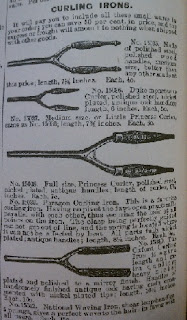We had some terrific guesses for last week's mystery artifact, which was (drumroll, please) . . . a curling iron! We actually have several curling irons in our collection, although the one pictured above is probably the oldest (we're guessing it dates to circa 1800). It's definitely the longest of the bunch, as well, measuring just under 18 inches in length!
Although we may tend to think of curling irons as a modern item, they are featured prominently in catalogs from the 19th Century. They were not an item marketed specifically for females, as the second curling iron in the advertisement from the 1897 Sears Roebuck catalog pictured below is described as a "Duke moustache Curler . . . Each 5c(ents)."
The photo below shows a different curling iron from our collection, one of many that are similar to the ones pictured above:
As this advertisement from the 1895 Montgomery Ward catalog shows, women took their curls very seriously -- at times opting to purchase pin-on bangs rather than take the time and trouble to self-style their hair!
The text for the La Toska Bang pictured above reads: "Ladies who do not require large, heavy front will find this a little gem; light and fluffy, ventilated foundation. Each, until sold $1.25." A fabulous description, although I have to confess, as a brunette, I take offense to the description of hair colors as red, gray, golden, and "drab" . . . "in switches, waves, bangs, etc." There were, however, several shades to choose from, and customers were instructed to "send samples of hair . . . (in) shade wanted, free from oil, folded up in a paper, pinned to your order and marked 'Sample,' to avoid any mistake."
Lest we assume that women were the only customers for false hairpieces, take note of the advertisement below for "Full Beards," "on wire" for $1.00 or "ventilated" for $2.00! The catalog also offers "mustache on wire spring, common" at 10 cents each or a dozen for 75 cents; "mustache, ventilated" for 20 cents; "imperials"; "goatees"; and "whiskers, side . . . each .75 (cents)."
As historians, archaeologists, and students of material culture, we can learn quite a bit from catalog advertisements regarding items of personal adornment and various presentations of the body. However, first-hand accounts can also tell us how people lived their lives, including how they utilized common objects when 'boughten' items were unavailable. In her book Little Town on the Prairie, Laura Ingalls Wilder (whose hair was a "pretty brown" and not "drab," thank you very much!) described begging her mother and father to be allowed to wear a bang, or "fringe." Having been given permission, she used Ma's sewing shears to cut "a narrow fringe about two inches long" which she then curled using a slate pencil:
"She laid her long slate pencil on the heater, and when it was heated she held it by the cool end and wound wisps of the short hair around the heated end. Holding each wisp tightly around the pencil, she curled all the bangs."






No comments:
Post a Comment